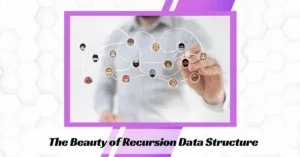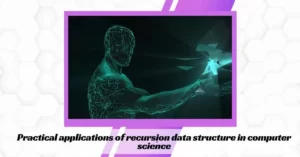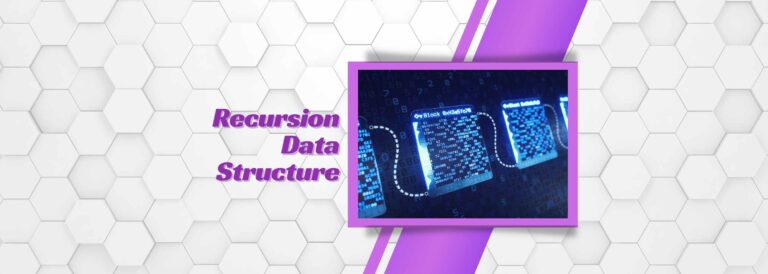Table of Contents
ToggleIntroduction
Recursion is a powerful programming technique that allows a function to call itself. It is an essential concept in computer science and is widely used in various algorithms, including searching, sorting, and traversing data structures.
In a recursive function, the function calls itself with a modified set of inputs until it reaches a base case. Recursion Data Structure, The base case is a condition that terminates the recursion and returns a value to the previous function call. The recursion continues until the base case is reached, and the function returns a result.
Recursion is best suited for problems that can be broken down into smaller sub-problems of the same type. For example, a factorial function can be defined recursively as the product of a number and the factorial of its predecessor.
Recursion has several advantages, such as simplifying code and reducing the number of variables needed. However, it can also lead to performance issues if not implemented correctly, as each recursive call adds a new stack frame to the call stack, which can result in a stack overflow if the recursion depth is too deep.
In summary, recursion is a powerful technique that allows a function to call itself to solve a problem. It is widely used in computer science, particularly in data structures and algorithms. However, it requires careful implementation to avoid performance issues.
The Beauty of Recursion Data Structure

Recursion is a powerful technique that can simplify coding and make it more elegant. It allows programmers to break down complex problems into smaller, more manageable pieces, which can be solved using the same set of instructions. This reduces the complexity of the code and makes it easier to understand and maintain.
One of the main advantages of recursion is that it reduces the need for loops and conditional statements. This is because the recursive function calls itself with a modified set of inputs until it reaches a base case. The base case is a condition that terminates the recursion and returns a value to the previous function call. Recursion Data Structure,This process continues until the base case is reached, and the function returns a result.
Another advantage of recursion is that it can handle nested data structures, such as trees and graphs, with ease. Recursive functions can traverse these structures, performing the same set of instructions at each level until the desired result is obtained.
Recursion can also simplify code by reducing the number of variables needed. In iterative solutions, variables are often used to keep track of the current state of the program. In contrast, recursive functions use the call stack to keep track of the current state, eliminating the need for additional variables.
In summary, recursion simplifies coding by breaking down complex problems into smaller, Recursion Data Structure, more manageable pieces, reducing the need for loops and conditional statements, and handling nested data structures with ease.
Recursive Functions

Recursive functions are a fundamental part of the power of recursion data structures. These functions can solve complex problems by breaking them down into smaller, more manageable subproblems.
The key feature of recursive functions is that they call themselves with modified inputs, each time moving closer to a base case that terminates the recursion. The base case is a condition that stops the recursive calls and returns a result to the previous call in the recursion stack.
Recursive functions are particularly useful in traversing complex data structures, such as trees, Recursion Data Structure, graphs, and linked lists. These structures often have nested levels that require the same set of operations to be performed at each level. Recursive functions can perform these operations on each level, moving through the structure until the base case is reached.
Another key advantage of recursive functions is that they can simplify code by eliminating the need for loops and conditionals. This can make the code easier to read, understand, and maintain.
However, recursive functions can also be challenging to implement and can lead to performance issues if not designed correctly. Each recursive call adds a new stack frame to the call stack, which can result in a stack overflow if the recursion depth is too deep.
In conclusion, recursive functions are a powerful tool in the arsenal of the recursion data structure. They allow programmers to solve complex problems by breaking them down into smaller, more manageable subproblems. While they have some limitations and can be tricky to implement, recursive functions offer a unique and elegant solution to many programming challenges.
Click here to know about: data analytics courses Kolkata
Practical Applications of Recursion Data Structure in Computer Science

Recursion data structure is a fundamental concept in computer science and has numerous practical applications. Here are some of the most common uses of recursion:
Searching and traversing: Recursion is widely used in searching and traversing complex data structures, such as trees, graphs, and linked lists. Recursive algorithms can move through the data structure, performing the same operation at each level until the desired result is found.
Sorting: Recursion is used in several sorting algorithms, including quicksort, mergesort, and heapsort. These algorithms divide the problem into smaller subproblems, sorting each subproblem recursively until the entire dataset is sorted.
Dynamic programming: Dynamic programming is a technique used to solve problems that can be divided into smaller subproblems. Recursion is often used in dynamic programming to break down the problem and solve it recursively.
Fractals: Fractals are complex geometric shapes that can be generated using recursive algorithms.Recursion Data Structure, The algorithm repeatedly applies a set of rules to a starting shape, creating increasingly complex patterns.
Backtracking: Backtracking is a technique used to find all possible solutions to a problem by trying different options and undoing them if they don’t work. Recursion is often used in backtracking algorithms to try all possible options and backtrack when a dead end is reached.
In conclusion, recursion data structure is a fundamental concept in computer science and has numerous practical applications in searching and traversing data structures, sorting, dynamic programming, fractals, and backtracking. These applications demonstrate the power and versatility of recursion in solving complex programming problems.
Recursive Algorithms

How Recursion Data Structure Enables Efficient Problem-S
olving
Recursive algorithms are a class of algorithms that use recursion data structure to solve complex problems. These algorithms can simplify coding and enable efficient problem-solving by breaking down complex problems into smaller, more manageable subproblems.
The key feature of recursive algorithms is that they call themselves with modified inputs, each time moving closer to a base case that terminates the recursion. This allows the algorithm to solve the problem by solving smaller subproblems recursively until the base case is reached.
One of the primary advantages of recursive algorithms is that they can handle nested data structures, such as trees and graphs, with ease. Recursive functions can traverse these structures, performing the same set of instructions at each level until the desired result is obtained.
Recursive algorithms are also useful in dynamic programming, a technique used to solve problems that can be divided into smaller subproblems. The recursive approach allows the algorithm to solve subproblems recursively, caching the results to avoid redundant calculations and improve performance.
Additionally, recursive algorithms can simplify code and make it more readable by reducing the need for loops and conditional statements. Recursive algorithms can be more elegant than iterative solutions and easier to understand and maintain.
In conclusion, recursive algorithms are an essential tool in the arsenal of the recursion data structure. They can solve complex problems efficiently by breaking them down into smaller, more manageable subproblems. By handling nested data structures with ease, enabling dynamic programming, and simplifying code, recursive algorithms demonstrate the power and versatility of recursion in problem-solving.
Recursion vs Iteration
Recursion and iteration are two techniques used in programming to solve problems. Recursion is a technique that involves breaking down a problem into smaller subproblems, while iteration is a technique that involves looping over a set of instructions until a condition is met. Both techniques have advantages and disadvantages, and the choice between them depends on the problem at hand.
One of the advantages of recursion is that it can handle nested data structures, such as trees and graphs, with ease. Recursive functions can traverse these structures, performing the same set of instructions at each level until the desired result is obtained. Recursion can also simplify code and make it more readable by reducing the need for loops and conditional statements.
However, recursion can have some disadvantages. Recursive functions can be more challenging to understand and debug, and they can be less efficient than iterative solutions in some cases. Recursive functions can also lead to stack overflow errors if the recursion depth is too deep.
On the other hand, iteration can be more efficient than recursion in some cases, as it avoids the overhead of function calls and stack management. Iteration can also be easier to understand and debug, as the flow of control is more explicit.
However, iteration can be less elegant than recursion, and it may require more code to solve the same problem. Iteration can also be more challenging to handle nested data structures, as it requires explicit management of loop counters and indices.
In conclusion, recursion and iteration are two powerful techniques used in programming to solve problems. Recursion is useful for handling nested data structures and simplifying code, while iteration is useful for efficiency and explicit control flow. The choice between them depends on the problem at hand and the specific requirements of the solution.
Also read: data science institute in Delhi
Common Pitfalls of Recursion Data Structure and How to Avoid Them
Recursion data structure is a powerful tool in programming, but it can also lead to some common pitfalls if not used correctly. Here are some of the most common pitfalls of recursion and how to avoid them:
Stack overflow: Recursive functions can lead to stack overflow errors if the recursion depth is too deep. This can be avoided by optimizing the code to reduce the number of function calls or using an iterative solution instead.
Infinite recursion: Infinite recursion can occur when a recursive function calls itself indefinitely. This can be avoided by ensuring that the function has a base case that terminates the recursion.
Redundant computation: Recursive algorithms can lead to redundant computations if the same subproblem is solved multiple times. This can be avoided by caching the results of previous computations and reusing them when needed.
Poor performance: Recursive algorithms can be less efficient than iterative solutions in some cases. This can be avoided by optimizing the algorithm and reducing the number of function calls.
Unnecessary recursion: Recursive algorithms can be overused, leading to unnecessary complexity and poor performance. Recursion Data Structure, This can be avoided by considering alternative solutions, such as iteration or dynamic programming.
In conclusion, recursion data structure is a powerful tool in programming, but it can also lead to common pitfalls if not used correctly. Stack overflow, infinite recursion, redundant computation, poor performance, and unnecessary recursion are all potential issues that can be avoided by optimizing the code, Recursion Data Structure, ensuring a base case, caching results, and considering alternative solutions. By being aware of these pitfalls and taking steps to avoid them, programmers can harness the power of recursion to solve complex problems efficiently and elegantly.
Recursion Data Structure in Action: A step-by-step Breakdown of a Recursive Program
To understand recursion data structure in action, let’s consider a simple example of a recursive program that calculates the factorial of a given number.
Here is the recursive function:
Arduino
def factorial(n):
if n == 1:
return 1
else:
return n * factorial(n-1)
Let’s walk through how this function works step-by-step for the input of 5:
The function is called with n=5
Since n is not equal to 1, the else block is executed, and the function returns n * factorial(n-1)
The function is called again with n-1=4
Since n is not equal to 1, the else block is executed, and the function returns n * factorial(n-1)
The function is called again with n-1=3
This process continues until n=1, which is the base case.
The base case is reached, and the function returns 1.
The result of the original function call is computed as 5 * 4 * 3 * 2 * 1 = 120.
In summary, the recursive function calculates the factorial of a number by breaking the problem down into smaller subproblems, solving each subproblem recursively until the base case is reached. The base case provides a termination condition for the recursion, and the function returns the result of the base case up the call stack to compute the final result.
Tips and Tricks for Mastering Recursion Data Structure in Programming
Recursion data structure is a powerful tool in programming, but it can be challenging to master. Here are some tips and tricks to help you become proficient in using recursion:
Understand the problem: Make sure you understand the problem and the requirements before attempting to solve it with recursion. Identify the base case and the recursive case and break the problem down into smaller subproblems.
Test small inputs: Test yo
ur recursive functions with small inputs to understand how they work and how the function calls are stacked on the call stack.
Draw diagrams: Draw diagrams or visualize the function calls and variable values to help you understand how the recursion is working and to debug any issues.
Use helper functions: Break complex problems down into smaller subproblems using helper functions. This can make the recursion more manageable and easier to debug.
Optimize for performance: Recursion data structure can be less efficient than iterative solutions in some cases, so optimize your code for performance by reducing the number of function calls and avoiding redundant computation.
Practice: Practice using recursion data structure on a variety of problems to become more comfortable with the technique.
Learn from others: Study and learn from existing code that uses recursion, read blogs and tutorials, and join online communities to learn from experienced programmers.
In conclusion, mastering recursion data structure requires practice, patience, and a deep understanding of the problem at hand. By following these tips and tricks and seeking out opportunities to learn from others, you can become proficient in using recursion to solve complex problems efficiently and elegantly.
Recursion Data Structure and Beyond: advanced concepts and techniques for experienced programmers
For experienced programmers, recursion data structure is just the beginning of the more advanced concepts and techniques that can be used to solve complex problems. Here are some advanced concepts and techniques that can be used in conjunction with recursion:
Memoization: Memoization is a technique that stores the results of expensive function calls and returns the cached result when the same inputs occur again, which can improve the performance of recursive functions.
Tail recursion: Tail recursion is a form of recursion in which the recursive call is the last operation performed in the function. This can optimize the function for space complexity and avoid stack overflow errors.
Dynamic programming: Dynamic programming is a technique that involves breaking a complex problem down into smaller subproblems and solving each subproblem only once, storing the solution and reusing it as needed. This can significantly improve the performance of recursive functions.
Divide and conquer: Divide and conquer is a technique that involves breaking a problem down into smaller subproblems, Recursion Data Structure, solving each subproblem independently, and combining the results to solve the original problem. This technique can be used with recursion to solve a variety of problems efficiently.
Backtracking: Backtracking is a technique that involves recursively trying out different solutions to a problem and undoing unsuccessful attempts until a successful solution is found. This technique can be used with recursion to solve problems such as searching for the shortest path in a maze.
In conclusion, recursion data structure is just one tool in the toolbox of experienced programmers. By combining recursion with advanced concepts and techniques such as memoization, tail recursion, dynamic programming, divide and conquer, and backtracking, programmers can solve complex problems more efficiently and elegantly.
Conclusion
In conclusion, recursion data structure is a powerful tool in programming that can simplify coding and enable efficient problem-solving. By breaking down complex problems into smaller subproblems and solving them recursively, programmers can write elegant and efficient code that is easier to read and maintain.
However, recursion can also be challenging to master, and it has its disadvantages compared to iterative solutions. It’s important to understand the problem requirements, use helper functions, and optimize for performance to avoid common pitfalls of recursion.
For experienced programmers, recursion is just the beginning of more advanced techniques such as memoization, tail recursion, dynamic programming, divide and conquer, and backtracking that can be used to solve complex problems efficiently and elegantly.
Overall, recursion data structure is a valuable tool in the programmer’s toolbox that can help solve a variety of problems in a clean and elegant way, but it should be used wisely and in conjunction with other techniques to achieve optimal results.
Frequently Asked Questions
What is recursion data structure?
Recursion is a programming technique that involves a function calling itself to solve a problem. Recursion data structure refers to the way that data is organized and processed in a recursive function.
What is a base case in recursion?
A base case is the condition that stops the recursion and returns a value. It is the simplest version of the problem that can be solved directly without further recursion.
When should recursion be used instead of iteration?
Recursion should be used when the problem can be broken down into smaller subproblems that are similar to the original problem, and the solution to the problem can be expressed in terms of the solution to the smaller subproblems. Iteration is better when the problem involves looping through a collection of items or performing a series of steps.
What are the disadvantages of recursion?
Recursion can be less efficient than iterative solutions, as it involves creating a new function call on the stack for each level of recursion. Additionally, recursion can be difficult to debug and can lead to stack overflow errors if not implemented carefully.
How can I optimize a recursive function?
There are several ways to optimize a recursive function, including using memoization to store previously computed results, tail recursion to optimize space complexity, and dynamic programming to avoid solving the same subproblem multiple times. It’s also important to optimize the base case and avoid redundant computation.













